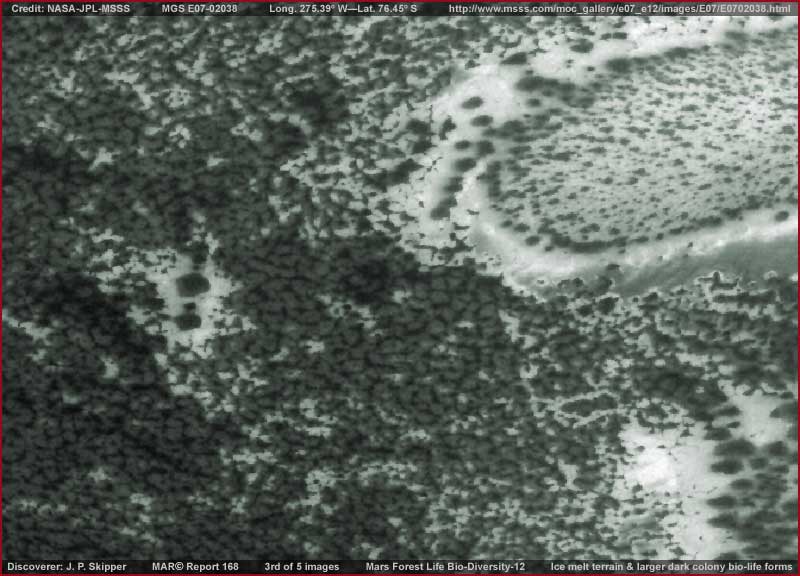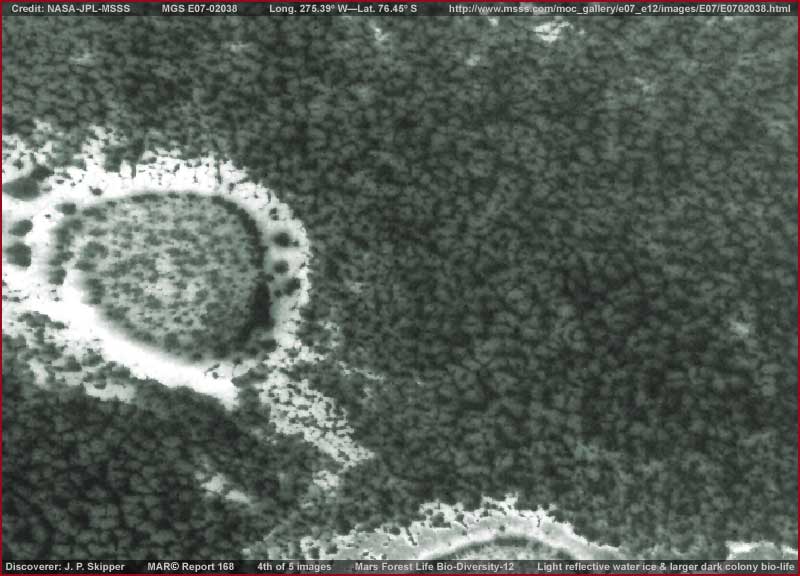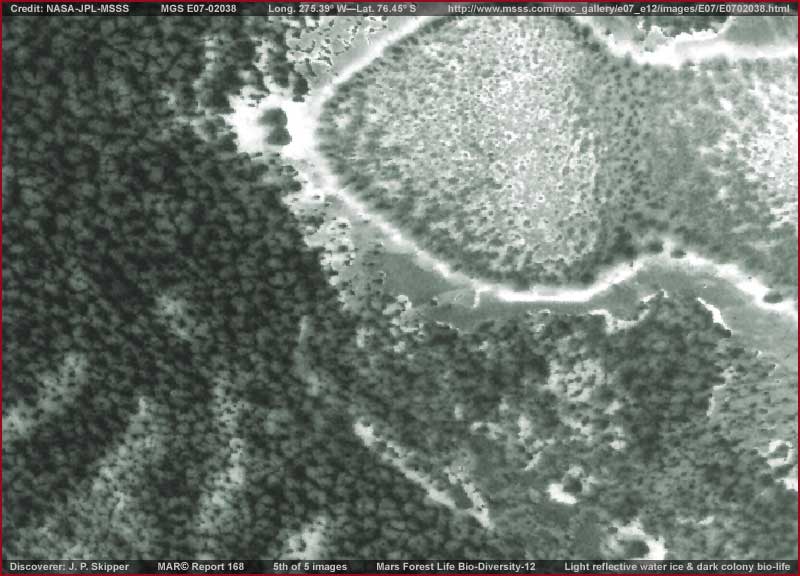
MARS FOREST LIFE
BIO-DIVERSITY-12
Report #168
August 30, 2009

This report derives from a single MGS
MOC E07-02038 image strip of a site in the South
Polar Region but well out from the Polar Cap. The view in all the report images
here is from one side edge of the strip to the other encompassing as much
context information as possible. The general terrain around this site area
is characterized by lowlands that tend to shallow water wet conditions at
certain times with most of the water sinking into the soil. When dryer colder
time comes, what water is left on the surface freezes into low level areas
of water ice and the sub-soil is infused with water ice.
An example of this is what you are seeing in the above first image. The most
light reflective areas above are low level water ice on the ground surface
while the less light reflective areas around it is dryer terrain. This dryer
terrain is dryer only in a relative sense to the more light reflective water
ice on top of the ground. In warmer periods, the water ice partially melts
into these lower profile looking surface ice area shapes soaking into the
terrain tending to infuse the relatively dryer terrain with moisture.
As you might logically surmise, the fairly plentiful presence of moisture
in this terrain logically creates good conditions for the presence of biological
life to take advantage of it. That is what you are looking at with respect
to the different dark spots you see both in the terrain and on the more light
reflective water ice. Most of this is colony life and particularly that on
the water ice. The following report images presented here will represent samples
of this living ecology further down the strip below this point. Not included
here is very light reflective terrain in the upper half of the strip where
reflectivity tends to wash out all evidence detail.

The above second image demonstrates a sample site below that presented in the first image. It is just more of the same but now note with less in larger area water ice on the surface and more dark biological life presence. Note that the dark bio-life here is not really mature enough and therefore large enough to be seen with better visual detail. Also note how the more light reflective but residual water ice tends to collect in the lower level areas tending to form depression like channels in the terrain.

The above third image is a spot a little
further down in the strip below the first and second image sites. Now in the
left and center areas note that we see the beginning presence of a larger
and a bit more mature form of what I call "clump" biological life
evidence. From a distant view above like this, the evidence tends to look
a little like individual tree tops but it is not a vegetative life forms like
trees.
Rather, it and its variations are colony major life forms of some kind unique
to this planet. This type of life comes in a number of variations that are
also very cold hardy. The variation seen here in this strip is adapted to
these South Polar region lowland conditions and look like this but there are
others. In my 2001 Report
#021 are larger forms looking very much like this but adapted to highland
terrain steep slopes. Also here in Report
#110 is very similar evidence and again in Report
#122 where the evidence is filling shallow trough systems on the South
Polar Cap ice itself. This life form is extremely tough and hardy but always
consider that it requires plentiful and consistent moisture presence.


The above fourth and fifth images moving
progressively down to the bottom of the strip demonstrates more of this major
biological life form presence in the terrain. Note that in these images the
evidence is in a more mature larger form and in greater densities. However,
the evidence here is in a more open configuration similar to a huge bush with
many branching's even though it is a colony form and what is seen here is
not its most mature form. In its most mature form it develops a more continuous
tough surface very similar to Earth Lichen as seen in the previous Reports
021, 110 and 122 at the above links.
I would say that that most of this terrain is sort of like a drying and not
entirely wet bog here on Earth. Whether you can buy into that moist terrain
concept or not, the one prevalent thing that cannot be missed here is that
the darker clumpy looking evidence is clearly not natural rock and soil geology
and just as clearly represents some form of biological living growth in this
terrain.
It isn't really doing it so much here in these scenes but this type of Mars
life in its more mature form can literally jamb into a given area with one
colony form pressing tightly against its neighbors completely filling any
sunlight space. However, it never mixes with each other and collectively forms
a pretty much level field of this evidence. Some gigantic variations of this
life form are so broad and of such a low level elevation that they can be
and are easily mistaken for cracked geological terrain on Mars.
When partially covered with snow that removes visible surface detail and leaves
only the narrow separation cracks between the colonies visible, this cracked
terrain impression is even more acute. Then only the huge size of the formations
give scientists pause in speculation as to what forces could cause such monstrous
geological cracking and especially in such uniform patterns?
What needs to be understood is that water presence is much more prevalent
in the South Polar Region than in the North Polar Region. In fact, some lowland
areas of the South Polar Region are subject to seasonal flooding spreading
out from the Cap with a rising water table in seasonal and general warming
trends. This means that there is a greater variety
of biological life present in the South Polar Region than in the North Polar
Region taking advantage of these more favorable conditions. In many places
in the South Polar Region the lowland soil areas tend to have a fairly high
residual moisture content year round that is more favorable for smaller size
bio-life that carpets the terrain choking out everything else and that smaller
life tends to be sunlight reflective rather than dark and light absorbing.
So when resolution is cut in an image to facilitate obfuscation, it is this
type of smaller carpeting life that is the most negatively impacted. The visuals
are so merged together by the poor resolution and the sunlight reflectivity
that the carpeting life looks more like continuous barren terrain. The upper
portion of this same reporting strip is like that. I don't show it here because
the only thing to see is light reflectivity off of broad surface areas with
little or no individual detail.
By contrast, the bio-life evidence pointed out here is both far larger and
darker giving some idea of individual shapes and then better visual recognition
follows. We here on Earth tend to think of dense forests as consisting of
trees and bushes as per our direct experience. However, although there are
conventional looking trees and bushes on Mars, there are also dense forests
of what appears to be mold and lichen like colony life in mega size forms
that tend to hug and carpet broad areas of terrain where the moist conditions
are more favorable to them.
They are one of the prevalent life forms on Mars even if they are unfamiliar
to the Earth human eye and not easy for us to visually recognize. The wind
carried reproductive spores cover vast areas resulting in the dark spots seen
everywhere in various stages from small and struggling to survive to flourishing
large densely packed forms covering broad areas. They usually do best where
moisture is consistently present in the soil and second best when water ice
on the surface is low profile and subject to warming conditions melt. In their
variety, they even contaminate and survive within surface water on the South
Polar Cap itself forming dark lanes in their millions that retain solar heat
that in turn erodes the Cap surfaces.
I come back to reporting on this evidence on occasions just because it is
strange and less obvious to the Earth human eye and therefore a little too
easy to be ignored because it is not understood. To adequately understand
Mars, one must also come to terms with understanding its unique biological
life differences that play a major role in the planet's development.
DOCUMENTATION
http://www.msss.com/moc_gallery/e07_e12/images/E07/E0702038.html:
This link connects you to the official MGS MOC E07-02038
science data 3rd listed stright .GIF strip sourced in this report. The evidence
starts in the last 40% of the strip and continues to the very bottom.
, Investigator
![]()